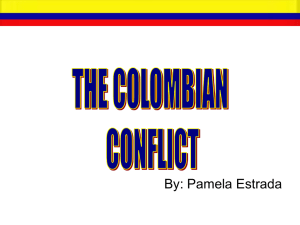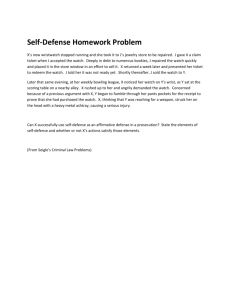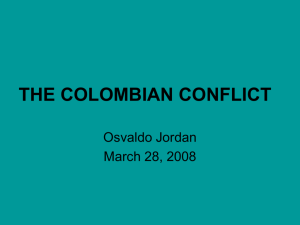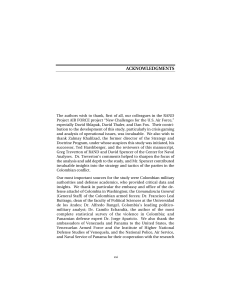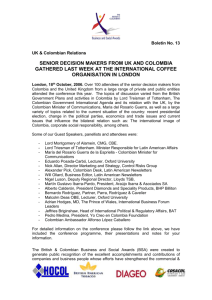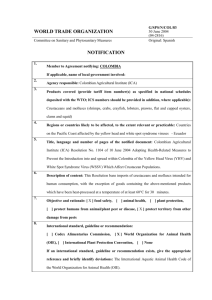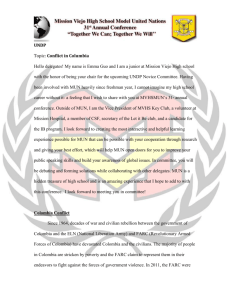THE ILLEGAL SELF-DEFENSE GROUPS: CAUSE OR SYMPTOM OF THE DISORDER?
advertisement
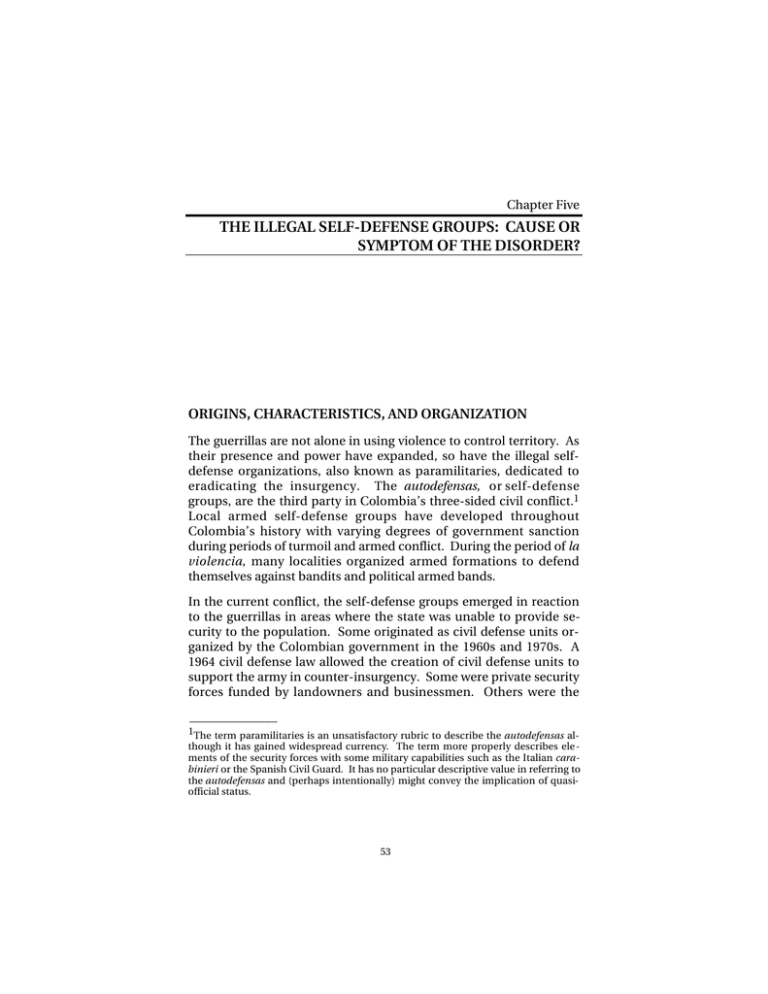
Chapter Five THE ILLEGAL SELF-DEFENSE GROUPS: CAUSE OR SYMPTOM OF THE DISORDER? ORIGINS, CHARACTERISTICS, AND ORGANIZATION The guerrillas are not alone in using violence to control territory. As their presence and power have expanded, so have the illegal selfdefense organizations, also known as paramilitaries, dedicated to eradicating the insurgency. The autodefensas, or self-defense groups, are the third party in Colombia’s three-sided civil conflict.1 Local armed self-defense groups have developed throughout Colombia’s history with varying degrees of government sanction during periods of turmoil and armed conflict. During the period of la violencia, many localities organized armed formations to defend themselves against bandits and political armed bands. In the current conflict, the self-defense groups emerged in reaction to the guerrillas in areas where the state was unable to provide security to the population. Some originated as civil defense units organized by the Colombian government in the 1960s and 1970s. A 1964 civil defense law allowed the creation of civil defense units to support the army in counter-insurgency. Some were private security forces funded by landowners and businessmen. Others were the ______________ 1The term paramilitaries is an unsatisfactory rubric to describe the autodefensas although it has gained widespread currency. The term more properly describes ele ments of the security forces with some military capabilities such as the Italian carabinieri or the Spanish Civil Guard. It has no particular descriptive value in referring to the autodefensas and (perhaps intentionally) might convey the implication of quasiofficial status. 53 54 Colombian Labyrinth bodyguards of drug traffickers and other criminals. In the 1980s, some of the legal self-defense units developed links with criminal elements, including drug-trafficking networks, and have become indistinguishable from criminal organizations. As the result of the involvement of some of these groups in criminal activities, the selfdefense units were outlawed in 1987. Nevertheless, the self-defense groups did not lay down their arms. In fact, they continued to grow and expand, now outside of any government control.2 Convivir units represent another model of self-defense organizations. Convivir, originated in Antioquia in the early 1990s and based on the neighborhood watch concept, was deliberately set up to avoid the appearance of the outlawed paramilitary groups. Convivir was a way of involving people in the struggle against the subversive organizations without organizing them as militias. These groups performed intelligence functions for the security forces and became the targets of guerrilla attack. Unlike the rondas campesinas, the Peruvian community self-defense militias that played a critical role in the defeat of the Shining Path insurgency, the Convivir groups were not allowed to carry rifles or heavier weapons needed to defend themselves effectively against guerrilla attacks.3 They could carry only side arms. In the mid-1990s, the Colombian government moved to dismantle the self-defense groups. The Convivir groups were declared illegal, allegedly on the grounds that some of them had begun to arm themselves unlawfully and had morphed into “illegal” selfdefense groups. The illegal self-defense organizations are far less cohesive than are the guerrillas, although in recent years the groups have clustered under an umbrella organization, the Autodefensas Unidas de Colombia (United Self-Defense Forces of Colombia), or AUC. The AUC brought to these groups some degree of central coordination, funding, and a coherent doctrine. There are currently some 8000 fighters in the AUC and a number of regional organizations, including the Autodefensas Campesinas de Córdoba y Urabá, Autodefensas ______________ 2Personal communication from Spencer, December 2000. 3By contrast, the Peruvian government distributed 10,000 rifles to the rondas by 1993. Cynthia McClintock, “The Decimation of Peru’s Sendero Luminoso,” in Cynthia J. Arnson, Comparative Peace Processes in Latin America, Woodrow Wilson Center Press, Washington, D.C., 1999, p. 236. The Illegal Self-Defense Groups: Cause or Symptom of the Disorder? 55 Casanare, Autodefensas de Santander y Sur del César, and the Autodefensas del Putumayo Bloque Sur. 4 The first of these organizations, the Autodefensas Campesinas de Córdoba y Urabá (ACCU) was established by the brothers Fidel and Carlos Castaño in Urabá to avenge the kidnapping and murder of their father by the FARC in 1981. Carlos Castaño became the AUC leader after Fidel’s death in an encounter with the FARC in 1996. In that same year, Castaño organized the AUC as a vehicle for a nationwide expansion of paramilitary activities. With better funding and equipment, the AUC formations have evolved from local militias to full-time professional fighters capable of offensive operations. From their base areas in Córdoba and the Urabá region in Antioquia on the Atlantic coast, the groups have contested control of a band of territory from northern Antioquia to the eastern plains. 5 They have succeeded in displacing the FARC from the area around San José del Guaviare, near the Venezuelan border, and from the area of Puerto Asís in Putumayo, formerly guerrilla strongholds. The strategy and tactics of the AUC mirror those of the guerrillas. The AUC is seeking to extend its control at the local level and to exercise political influence through the control or intimidation of local officials. Its strategy is to dispute control of the drug-producing areas where the guerrillas have their main sources of income. 6 For this reason, Guaviare, Putumayo, and Caquetá have become a major battleground in the struggle between the FARC and the AUC. In Florencia, the capital of Caquetá, 256 homicides were registered in a three-month period as the result of the FARC-AUC power struggle. 7 Illegal self-defense groups are considered responsible for the majority of the reported mass killings by organized groups. It is estimated ______________ 4 Colombian armed forces briefing March 2000; “Outlaw Unit Offers Help in Drug War,” Washington Times, May 16, 2000. 5Rangel takes the view that the paramilitaries’ military objective is to penetrate the FARC’s strategic rear guard in the south and seize control of the area’s cocaine industry. Rangel, pp. 49–50. 6Rangel, p. 50. 7Presentation by Lucrecia Murcia, mayor of Florencia, at Georgetown University and National Endowment for Democracy Conference on “Local Government Amidst the Armed Conflict: The Experience of Colombian Mayors,” Washington, D.C., September 27, 2000. 56 Colombian Labyrinth that of 23,184 persons murdered by illegal armed organizations between 1988 and 1997, 3532 were killed by guerrillas and 19,652 by other organizations, which include illegal self-defense organizations, the drug cartels, and “private justice” groups.8 In contested areas, AUC forces routinely execute alleged guerrilla sympathizers to instill fear and compel support among the local population. The AUC also engaged in large-scale attacks on villages suspected of supporting the guerrillas, in retaliation for guerrilla attacks, or to remove the guerrillas’ support network.9 The AUC acknowledges these massacres, but argues that the killings are conducted on the basis of intelligence on FARC collaborators, often provided by FARC deserters from the area. A well-informed observer of the Colombian military situation noted that there are in fact numerous FARC deserters in the AUC ranks, because of the harsh discipline imposed by the FARC and because the AUC offers protection from retaliation by their former comrades.10 Despite the atrocities attributed to them, the Colombian public views the illegal self-defense groups less unfavorably than the guerrillas. An October 1999 Yankelovich, Acevedo and Associates poll asked who were the greatest enemies of Colombia’s welfare. Thirty-nine percent of the respondents chose the guerrillas, 9 percent common criminals, and 8 percent the paramilitaries. Twenty-three percent ______________ 8Echandía, p. 69. Echandía cautions that these figures, from the Colombian government’s Departamento Administrativo de Seguridad (DAS) data, underestimate the real numbers. The annual number of murders in Colombia in this period ranges from 21,500 to over 28,000, or a rate of 73.58 to 86.05 per 100,000 inhabitants. Ibid., pp. 235– 236. 9For instance, in January 1999, AUC men swept through villages in six departments and killed some 150 suspected guerrilla sympathizers in retaliation for a bloody FARC attack on the AUC headquarters at El Nudo de Paramillo in December 1998. The Economist, January 16, 1999. 10 Guerrillas have been primarily responsible for the majority of all other types of human rights violations, including murders fewer than four persons, kidnappings, attacks on population centers, and acts of terrorism. See table in República de Colombia, Ministerio de Defensa Nacional, La fuerza pública y los derechos humanos en Colombia, Bogotá, March 2000, p. 14. Although there were some widely publicized massacres in 1999 and 2000, the trend in the number of mass murders (those involving four or more victims)—the type of crime often associated with the AUC—has been downward since 1990, as shown in Echandía, p. 71. Since there has not been a decrease in AUC activity in this time frame, this trend might reflect a decision by AUC leaders to avoid the type of high-profile atrocities that would further reduce their prospects of acceptance as legitimate political actors. The Illegal Self-Defense Groups: Cause or Symptom of the Disorder? 57 chose “others”; 19 percent “all of the above”; and 1 percent the armed forces. 11 ALLEGATIONS OF COLLUSION WITH THE COLOMBIAN MILITARY Cooperation, tacit or open, between the AUC and the Colombian army has repeatedly been alleged. The gunmen who carried out a massacre at the town of El Tigre in January 1999 were reported to have arrived in four trucks belonging to the army’s 24th Brigade.12 Guerrillas and human rights activists accuse the army and AUC of cooperating in activities against the rebels’ civilian supporters. According to press reports, a number of senior paramilitary leaders in Putumayo previously served as noncommissioned officers (NCOs) or junior officers in the Colombian military.13 The diverse and changing nature of the self-defense groups makes it difficult to analyze their relationship with the Colombian military, particularly at the local level. The Colombian government has declared the battle against the illegal self-defense groups a strategic priority and has established the National Coordination Center to lead the fight against these groups.14 According to Colombian government data, between 1997 and 1999, 76 members of illegal selfdefense groups were killed in confrontations with the security forces and 705 were captured. In the same period, 2677 members of guerrilla organizations were killed and 3796 captured. The number of paramilitaries killed and captured represented, respectively, 1.36 percent and 12.63 percent of the total force. For the guerrillas, the proportions of personnel killed and captured were, respectively, 10.37 percent and 14.72 percent. Colombian authorities point to the close ratios of captured paramilitaries and guerrillas as evidence of even-handedness. With regard to the disproportion in the ratios of those killed in action, the Colom______________ 11See table in La fuerza pública y los derechos humanos en Colombia, p. 29. 12The Economist, January 16, 1999. 13“Outlaw Unit Offers Help in Drug War,” Washington Times, May 16, 2000. 14“Fight Against Illegal Self-Defenses,” Colombian Ministry of Defense, 2000. 58 Colombian Labyrinth bian Ministry of Defense human rights report notes that the results could hardly have been different, given that the guerrillas are much more likely to seek confrontation with the armed forces than are the illegal self-defense forces.15 The Colombian authorities have also taken steps against officers accused of collaborating with paramilitaries or failing to prevent attacks on civilians. In July 2000, the Office of the Procurator General indicted four generals and a colonel for failing to take measures to prevent the killing of 18 villagers at Puerto Alvira, Meta, in May 1998.16 One of the officers, Brigadier General Jaime Uscategui, former commander of the 7th Brigade, was subsequently found guilty by a military court-martial of failing to prevent an earlier massacre in Mapiripán, Meta, in which 30 people were murdered.17 In October 2000, the Minister of Defense announced the dismissal of 388 officers and noncommissioned officers for human rights abuses, corruption, and other reasons, as part of an effort to improve the military’s performance.18 LINKS TO THE DRUG TRADE The extent of the income that the illegal self-defense groups derive from the narcotics trade is not known, but it is believed to be considerable. As noted in Table 3.1, eight of 19 squads associated with Carlos Castaño’s AUC are considered by Colombian authorities to be linked to the drug trade. In a televised interview in March 2000, Cas______________ 15For instance, according to Colombian government data, of 115 attacks on population centers in 1999, 106 were carried out by guerrillas and nine by illegal self-defense forces. La fuerza pública y los derechos humanos en Colombia, pp. 20–21. Broken down by year, the data show an increase of the ratio of members of illegal self-defense forces killed in action to those in the total force from 0.25 percent in 1996 to about 5 percent in 1999, suggesting a tougher approach by the authorities. 16The army responded that two of the generals had left their commands in the area five months before the incident occurred, and that the nearest army troops were 100 km from the site and therefore could not have prevented the incident. “Cargos contra 4 generales por masacre de Puerto Alvira,” El Tiempo, July 28, 2000. 17Semana, “General condenado,” February 19–25, 2001. 18The officers and NCOs were dismissed pursuant to a decree signed by President Pastrana allowing the Minister of Defense to dismiss officers deemed unfit for duty; they were not charged with specific abuses. “Colombian Military Fires 388 in Human Rights Effort,” Washington Post, October 17, 2000. The Illegal Self-Defense Groups: Cause or Symptom of the Disorder? 59 taño admitted that drug trafficking and taxation of peasants producing coca in Antioquia and Córdoba provided up to 70 percent of the financing for his forces (with the rest largely coming from extortion).19 According to testimony of a U.S. Drug Enforcement Agency (DEA) official, the Castaño organization appears to be directly involved in processing cocaine and at least one of the paramilitary groups appears to be involved in exporting cocaine from Colombia.20 POLITICAL ACTORS OR CRIMINALS? The strategic issue for the Colombian government is whether the self-defense groups should be treated as political actors—and therefore as legitimate participants in the peace negotiations—or as criminals to be suppressed. The AUC’s near-term political objective is legitimacy and equal status with the guerrillas as political actors. Consequently, the AUC wants a seat at the table as a third party, although its leaders may actually have an interest in the continuation of the conflict, which perpetuates the conditions that permit the expansion of AUC influence.21 The Colombian government takes the view that the AUC is not a legitimate political organization and has excluded it from the negotiations. Although the Colombian government is committed to fighting the AUC as well as the guerrillas, the illegal self-defense groups are not seen by some sectors of Colombian public opinion as a strategic threat to the state in the same way that the guerrillas are. From a pragmatic standpoint, whether the AUC is accepted as a legitimate political actor or not, it has become another competing power center challenging the state’s frayed authority. Realistically, to the extent that these groups are the products of an environment of insecurity brought about by guerrilla activity and state weakness, ______________ 19“Colombian Death Squad Leader Reveals His Face,” CNN Interactive World Wide News, March 2, 2000. See also Bagley, “The Evolution of Drug Trafficking in Colombia in the 1990s,” pp. 9–10; and “The Andean Coca Wars: The Crop That Refuses to Die,” The Economist, March 4, 2000. 20William Ledwith, Chief of the Drug Enforcement Agency’s International Operations, before the House Government Reform Committee, Criminal Justice, Drug Policy and Human Resources Subcommittee, Washington, D.C., February 15, 2000. 21Rangel, p. 48. 60 Colombian Labyrinth they will continue to be a factor in Colombia’s crisis as long as conditions are not changed.22 In view of these circumstances, it may be worth considering whether the policy of discouraging the organization of legal self-defense communities is wise. A network of supervised self-defense organizations on the Peruvian model could provide an alternative to the illegal groups. In the case of Peru, beginning with the administration of Alan García in the late 1980s and continuing under Fujimori, the Lima government organized and armed some 4000 rondas campesinas, or community self-defense militias. These militias played a decisive role in the defeat of the Peruvian insurgencies.23 In the Colombian situation, a network of properly supervised self-defense organizations could give the state a better handle on the activities of self-organized local groups. Another alternative, suggested by military analyst David Spencer, is the establishment of National Guard units to provide local defense. To establish a National Guard organization, the Colombian military could draw on the pool of trained manpower created by the conscription system now in effect.24 Whatever the modalities, such arrangements might help to create the conditions for a peace agreement by empowering local communities to provide for their security and creating incentives for the guerrillas to negotiate in good faith. ______________ 22 At a conference in Washington, D.C., on September 27, 2000, it was the nearunanimous view of the Colombian mayors that it would be difficult to slow the growth of the illegal self-defense groups in the absence of an effective government presence at the local level. 23See Cynthia McClintock, “The Decimation of Peru’s Sendero Luminoso,” in Arnson. 24Personal communication from David Spencer, December 2000.
